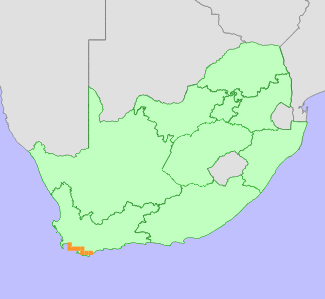|
Scientific Name | Serruria adscendens (Lam.) R.Br. |
Higher Classification | Dicotyledons |
Family | PROTEACEAE |
Common Names | Kleinmond Spiderhead (e) |
National Status |
Status and Criteria | Near Threatened A2c |
Assessment Date | 2020/04/19 |
Assessor(s) | A.G. Rebelo, D. Raimondo & L. von Staden |
Justification | Serruria adscendens is endemic to two mountain chains in the Western Cape Province, South Africa, it has an extent of occurrence (EOO) of 2346 km² and an area of occupancy of 232 km². While 19 locations are recorded for this species, 12 of which fall within protected areas, this species is suspected to have experienced a 25% decline in the population in the past three generations (since 1975). A total of 10% of this loss is due to irreversible habitat transformation to coastal housing developments and to the planting of protea orchards for the cut flower industry. A further 15% of its population is suspected to have been lost to invasive alien plant infestations and too frequent fire return intervals. As a species that is killed by fire with recruitment following burn events, sufficient time intervals between burns is needed for seedbanks to be established. The pressure from both invasive alien plant species and invasive alien ants that displace much needed seed dispersal mutualisms with indigenous ants is causing a continuing decline to the population. This species therefore qualifies for listing as Near Threatened under criterion A. |
Distribution |
Endemism | South African endemic |
Provincial distribution | Western Cape |
Range | This species is endemic to the Western Cape Province, South Africa and stretches from the Hottentots Holland to Kleinrivier Mountains. |
Habitat and Ecology |
Major system | Terrestrial |
Major habitats | Overberg Sandstone Fynbos, Kogelberg Sandstone Fynbos, Hangklip Sand Fynbos |
Description | It grows in sandstone fynbos on lower slopes. Mature individuals are killed by fires, and only seeds survive. Seeds are relased after ripening, and dispersed by ants to their underground nests, where they are protected from predation and fire. It is pollinated by insects. |
Threats |
| This species faces multiple threats, 16% of its former habitat has been irreversibly transformed for coastal housing developments, with 10% of this loss having taken place in the past three generations (post 1975). A further 15% of this species' formerly occupied habitat has been severely degraded as a result of invasive alien plant species outcompeting the coastal fynbos vegetation and due to too frequent fire return intervals which results in the loss of this reseeding species. Another threat is invasive ant species that are displacing native ant species. Invasive ants do not perform the function of indigenous ants, which is to bury this species' seeds in their nests where they are protected from fire. Large scale ant invasions lead to population collapse as there is no soil-stored seed bank to regenerate from post fire. Invasive alien plant and ant spread in combination with too frequent fires takes place both within and outside of protected areas. |
Population |
S. adscendens is found in large stands in fynbos on low mountain slopes and on flats. At least 59 subpopulations from 19 locations have been documented. While there are many individuals in each stand, its habitat specificity and vulnerability of this species to the impacts of fire and invasive alien plants and ants means there is ongoing decline of mature individuals taking place.
|
Population trend | Decreasing |
Conservation |
| It is present in Kogelberg, Brodie-Link, Kleinmond, Fernkloof, and Vogelgat nature reserves. |
Assessment History |
Taxon assessed |
Status and Criteria |
Citation/Red List version | | Serruria adscendens (Lam.) R.Br. | NT A2c; B1ab(iii)+2ab(iii) | Raimondo et al. (2009) | |
Bibliography |
Goldblatt, P. and Manning, J.C. 2000. Cape Plants: A conspectus of the Cape Flora of South Africa. Strelitzia 9. National Botanical Institute, Cape Town.
Manning, J.C. and Goldblatt, P. 2012. Plants of the Greater Cape Floristic Region 1: The Core Cape Flora. Strelitzia 29. South African National Biodiversity Institute, Pretoria.
Raimondo, D., von Staden, L., Foden, W., Victor, J.E., Helme, N.A., Turner, R.C., Kamundi, D.A. and Manyama, P.A. 2009. Red List of South African Plants. Strelitzia 25. South African National Biodiversity Institute, Pretoria.
Rebelo, T. 2001. Sasol Proteas: A field guide to the proteas of southern Africa. (2nd ed.). Fernwood Press, Vlaeberg, Cape Town.
|
Citation |
| Rebelo, A.G., Raimondo, D. & von Staden, L. 2020. Serruria adscendens (Lam.) R.Br. National Assessment: Red List of South African Plants version . Accessed on 2025/04/14 |
 Comment on this assessment
Comment on this assessment

